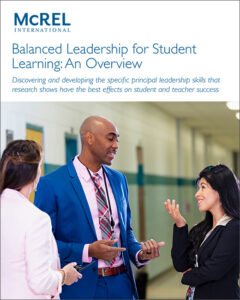Effective school-level leaders impact student achievement. McREL’s analysis of research found that effective leadership is not about leader personality or style; rather, it’s about a set of 21 specific actions and behaviors that are significantly associated with higher levels of student learning, teacher efficacy, and school improvement. This paper lists the 21 Balanced Leadership for Student Learning actions and explains how they are organized into three primary components of effective school leadership:
Establishing and maintaining a clear schoolwide focus on what matters most: consistently delivering high-quality instruction for all students.
Inspiring, leading, and sustaining changes in school processes and operations that are needed in order to create better conditions for high-quality teaching and learning.
Creating a purposeful school community that has a united vision for what they want the school to be and has a shared belief that, working together, they have what it takes to make that vision come true.
These three Balanced Leadership components exist within a landscape of intentional leadership. Effective school and district leaders are intentional about their leadership based on the needs of their students, teachers and support staff, parents, and community.
School-level leaders need to identify the strengths of their school, the areas in need of improvement, and the changes that need to occur to produce better results—and then they need to match their own leadership behaviors to the ones research has shown to effect positive change.
Sometimes, leaders need to be directive, leading from the top down if changes are needed quickly. At other times, the same leaders need to include others within the school to engage in shared decision-making, especially for more complex issues and initiatives that need broad ownership and engagement with the solutions. Neither approach works in all situations and leaders must determine what their school needs in the moment from their leadership and apply the leadership responsibilities in ways that help advance the work of teaching and learning.
The paper also crosswalks major features and content of Balanced Leadership with leadership frameworks from the Wallace Foundation and the National Policy Board for Educational Administration.
To view and download a free copy of this paper, please complete the information below and click “Submit.”
We will also add you to our email list so that you can learn more about this topic and other resources from McREL.

